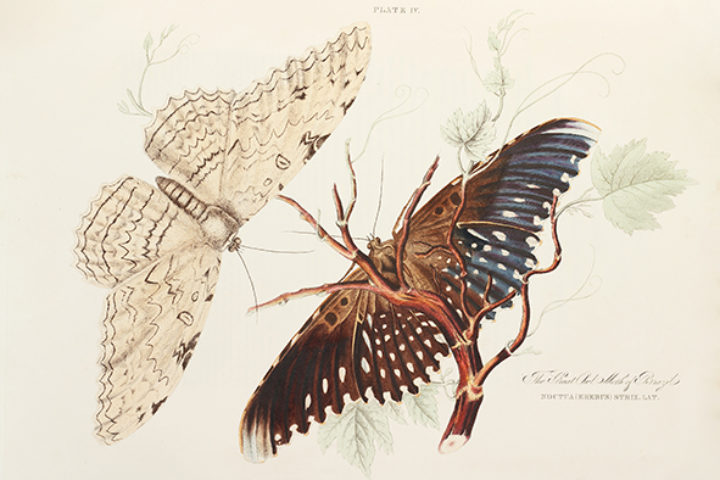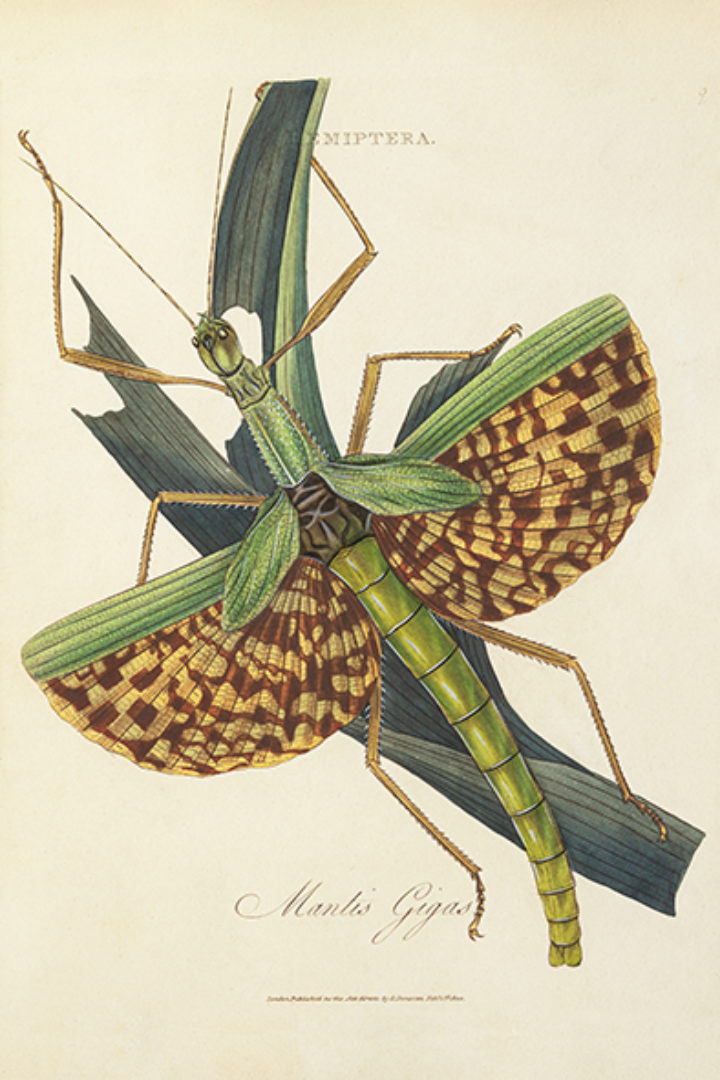Entomology
The Linnaean collections hold over 3,000 insects, almost two-thirds of which were subsequently contributed by our Founder, James Edward Smith. Some were later designated as type specimens (the specimen upon which the description of a species is based). We are also home to many books and manuscripts dedicated to the study of insects.

'[Papilio Menelaus]', Maria Sibylla Merian, Dissertatio de generatione et metamorphosibus insectorum Surinamensium, Fig. 53 (1719, RFF.719)
This plate by the German naturalist and intrepid traveller Maria Sibylla Merian (1647–1717) is from her famous entomological book Metamorphosis insectorum Surinamensium. (The Society's copy is a slightly later version with an alternate title.) Merian had been trained in illustration by her step-father. During this period, many naturalists thought that insects were born of 'spontaneous generation'. Merian had raised silk worms as a child and drew illustrations of their life cycle stages, and Metamorphosis insectorum Surinamensium would be one of the first publications to depict the full life-cycle of many insect species. Though it was normal for women of her era and status to collect butterflies, Merian drew them and recorded their habitat information and other scientifically useful descriptions. She went even further and, at the age of 52, travelled to Dutch Guiana to study and record the tropical insects native to the region and their host plants. Linnaeus would go on to use her descriptions as the basis for some of his own work on insect classification, citing this plate when writing his description of the Papilio menelaus species (current name: Morpho menelaus) in Systema naturae (1758). In the top right we see a large depiction of the Menelaus blue morpho butterfly, and the handwritten note at the foot of the plate reads 'Papilio Menelaus 748', the species' original name and a number referring to a specimen in the Linnaean insect collections.

'[Butterfly specimens]', Linnaean Insects, Lepidoptera Box 43
The 23 butterfly specimens in this box were all part of Linnean Society founder Sir James Edwards Smith's (1759–1828) collection. Although referred to as the Linnaean Insect Collection, it is estimated that only about one-third of the insect specimens belonged to Linnaeus, as the collection was later added to by Smith. Like Linnaeus before him, Smith was in correspondence with naturalists and collectors around the globe. Many of these specimens were collected by Nathaniel Edward Kindersley (1763–1831), an English civil service officer with the British East India Company: Kindersley sent Smith at least 277 insect specimens. A few of the specimens were also collected by Scottish surgeon and botanist William Roxburgh FLS (1751–1815) in Bengal, who appears to have started his correspondence with—and collecting for—Smith through Kindersley. Thomas Marsham FLS (1748–1819), who was the first secretary and one of the original seven Fellows of the Linnean Society, also contributed to the collection of specimens in this box. As shown by all of our collections, the Society was very much, and still is, a place for scientific and artistic collaboration.

'[Hercules beetles]', Linnaean Insects, Coleoptera Box 1
Hercules beetles (current name: Dynastes hercules) can be found in Mexico and Central and South America. They can grow to be 18 cm long (including their long horns) and are amongst the largest beetle species, feeding on rotting fruit. Males have large upper (thoracic) and lower (cephalic) horns, though studies show that the horn size is not important to females when selecting a mate. The males use their large horns as weapons when competing for females and have been used as models in studying sexual selection; they will trap their competitor in a pincer movement, and throw them. The largest specimen in the left side of this box is from Linnaeus' collection, and is the lectotype.

'Myrmeleon sp.', Linnaean Insects, Neuroptera Box 17 (LINN 4924)
This specimen from the Myrmeleon, or antlion, genus has been labelled as 'Myrmeleon sp.' because the species of this specimen has not yet been formally identified. Antlions resemble dragonflies and damselflies, however most antlions are brown and as they belong to the Order Neuroptera (net-winged insects), antlions have many more tiny cells in their wings, which can be seen here. Antlions are also nocturnal. They get their name from the predatory behaviour of their larvae, which dig pits to trap passing ants.

'The Great Owl Moth of Brazil', James Wilson, Illustrations of zoology, No. 1, Pl. IV (1831, MS/DAR/270.4:20)
James Wilson (1795–1856) was a Scottish zoologist. His Illustrations of zoology, being representations of new, rare or otherwise remarkable subjects of the animal kingdom was published in nine parts, with four plates of animals drawn from nature in each part. Wilson drew these animals from specimens belonging to the Museum of the University of Edinburgh, with which he was associated. The copy in which this plate is found belonged to Charles Darwin FLS (1809-1882), and is part of the Society's Darwin-Wallace collection. The Society holds all nine parts that were owned by Darwin, which came unbound with the covers and leaves stab-sewn together with silk ribbon. Shown here is the common owl moth, found in the subtropical regions of Africa and Asia, and first described by Linnaeus in 1768. It is a relatively large species, with a wingspan of 12 to 16 cm, and eyespots that may serve to confuse or startle potential predators.
![Illustration of '[Chief enemies destructive to the Coffee plant]'](https://ca1-tls.edcdn.com/content/_720xAUTO_crop_center-center_none/Shortt-Abbot_SP-1033_web.jpg)
'[Chief enemies destructive to the Coffee plant]', C. Abboy (artist), John Shortt (author), 'A brief account of the chief enemies destructive to the Coffee plant' (c.1868, SP/1033/2)
This watercolour drawing by C. Abboy accompanied the paper, 'A brief account of the chief enemies destructive to the Coffee plant' by John Shortt FLS (1822–1889), read at the Society on 7 May 1868. (Shortt was an Anglo-Indian surgeon working for the British East India Company who published several papers with the Society.) The drawing depicts 27 images of life cycles of insects and how they destroy the coffee plant, including the life cycles of the 'Perforator Choavensis' (White Borer), 'Curculio Coffeeophagus', 'Zeuzera Osculi' (Red Borer), and 'Gryllus Viridissimus' (Tettigonia viridissima; great green bush-cricket), of which the Society may have the syntype.
![[Mantid and phasmid specimens]](https://ca1-tls.edcdn.com/content/_720xAUTO_crop_center-center_none/Hemiptera_Box10_Mantis_web.jpg)
'[Mantid and phasmid specimens]', Linnaean Insects, Hemiptera Box 10
The largest specimen in this box has been identified as Diapherodes angulata; the top three left and bottom right specimens are phasmids (stick insects), while the three around the bottom left corner are mantids (praying mantises).

'Mantis Gigas', Edward Donovan, An epitome of the natural history of the insects of India and the islands in the Indian seas, Plate 9 (1800-1804, Q 915.4:575.7 DON)
Elijah Edward Donovan FLS (died 1837) was a naturalist, publisher and illustrator. His origins are unknown and there is no evidence that he travelled outside of England and Wales. Instead, for Insects of India, which was the first illustrated publication on Indian entomology, he described and drew from species in his own collection. The work confusingly includes species not native to India for two reasons: 1) the work also includes species from 'islands in the Indian seas', as indicated in the full title; and 2) the publication was based on works by Johan Christian Fabricius (1745–1808) who uses 'Indiis' to refer to the West Indies and northern South America. The giant stick insect (current name: Phasma gigas) is not a native to India but to the Maluku islands in the Indonesian archipelago.
